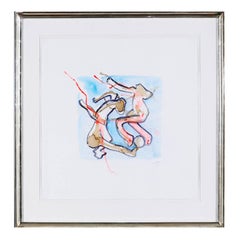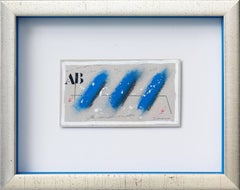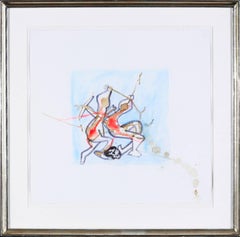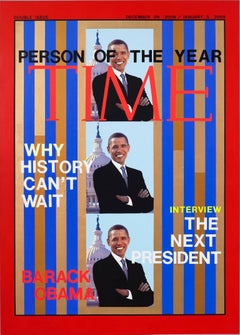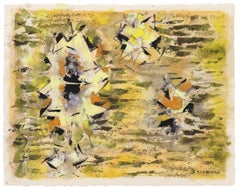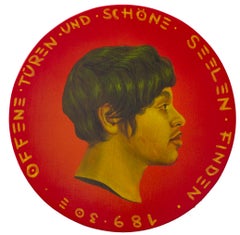Galleri GKM AB Mixed Media
to
4
2
2
1
2
1
Overall Height
to
Overall Width
to
2
1
1
2
2
2
2
1
1
4
1
By Roberto Matta
Located in Malmo, SE
Pastel, gouache and coffee on paper.
Artwork size: 58 x 56 cm.
Frame size: 78 x 76 cm.
Free shipment worldwide.
Acquired directly from the artist.
Archive number (P90/37)
“The heart is an eye,” writes Nobel laureate Octavio Paz in an essay on Matta’s paintings. Matta creates a world coloured both by a sunny faith in the future and by visions of impending doom.
Roberto Sebastian Echaurren Antonio Matta, who died aged 91 on 23 November 2002, was born in Santiago, Chile, on 11 November 1911 into a family with Spanish, French and Basque roots, and raised in an atmosphere of religiosity. By the age of 21 he had graduated and begun work as an architect, but his leisure time he devoted to sketching and painting. In 1933 he travelled to Europe for the first time, visiting Greece, Yugoslavia, Italy and other countries, and subsequently taking the initiative to collaborate with the architect, Le Corbusier. As time passed, however, Matta’s enthusiasm for a career in architecture waned, and he began to devote himself full-time to art, making early acquaintances with surrealists such as Max Ernst, Salvador Dalí, André Breton and others.
Between 1939 and 1948 Matta, like many of his artistic contemporaries, lived in self-imposed exile in the USA, but, after almost 10 years’ absence from Europe, he returned to make first Rome and then, a few years later, Paris his home. Throughout most of the rest of his life Matta commuted between his studio in Paris and his creative refuge in the monastery outside Rome. And it is here, in Italy, that he produced his greatest paintings.
Matta’s first retrospective in Sweden was organised in 1956 when his works were exhibited in what was then Galerie Colibri – run by, among others, the artist C O Hultén at number 36 Södra Förstadsgatan in Malmö, Sweden. This was also the time when Matta began to collaborate with poets and other artists in Sweden. He produced the illustrations for Lasse Söderberg’s first anthology of poems, Akrobaterna (“The Acrobats”), published in 1955, and was also responsible for the cover of the Swedish art and literary magazine Salamander.
In 1959 the first museum exhibition of Matta’s work in Europe was arranged at the Museum of Modern Art (Moderna Museet) in Stockholm. Held under the aegis of Pontus Hultén, it was entitled “Fifteen Forms of Doubt” and included 15 or so gigantic paintings...
Category
1990s Abstract Mixed Media
Materials
Mixed Media
By James Coignard
Located in Malmo, SE
Acquired directly from the artist.
Unique artwork.
Artwork size: 9,5 x 17 cm.
Frame size: 27 x 34 cm
Frame in si...
Category
Early 2000s Abstract Mixed Media
Materials
Mixed Media
By Roberto Matta
Located in Malmo, SE
Artwork size: 56 x 58 cm.
Frame size: 76 x 78 cm.
Free shipment worldwide.
Archive number (P90/36)
Acquired directly from the artist.
“The heart is an eye,” writes Nobel laureate Octavio Paz in an essay on Matta’s paintings. Matta creates a world coloured both by a sunny faith in the future and by visions of impending doom. Roberto Sebastian Echaurren Antonio Matta, who died aged 91 on 23 November 2002, was born in Santiago, Chile, on 11 November 1911 into a family with Spanish, French and Basque roots, and raised in an atmosphere of religiosity. By the age of 21 he had graduated and begun work as an architect, but his leisure time he devoted to sketching and painting. In 1933 he travelled to Europe for the first time, visiting Greece, Yugoslavia, Italy and other countries, and subsequently taking the initiative to collaborate with the architect, Le Corbusier. As time passed, however, Matta’s enthusiasm for a career in architecture waned, and he began to devote himself full-time to art, making early acquaintances with surrealists such as Max Ernst, Salvador Dalí, André Breton and others. Between 1939 and 1948 Matta, like many of his artistic contemporaries, lived in self-imposed exile in the USA, but, after almost 10 years’ absence from Europe, he returned to make first Rome and then, a few years later, Paris his home. Throughout most of the rest of his life Matta commuted between his studio in Paris and his creative refuge in the monastery outside Rome. And it is here, in Italy, that he produced his greatest paintings. Matta’s first retrospective in Sweden was organised in 1956 when his works were exhibited in what was then Galerie Colibri – run by, among others, the artist C O Hultén at number 36 Södra Förstadsgatan in Malmö, Sweden. This was also the time when Matta began to collaborate with poets and other artists in Sweden. He produced the illustrations for Lasse Söderberg’s first anthology of poems, Akrobaterna (“The Acrobats”), published in 1955, and was also responsible for the cover of the Swedish art and literary magazine Salamander. In 1959 the first museum exhibition of Matta’s work in Europe was arranged at the Museum of Modern Art (Moderna Museet) in Stockholm. Held under the aegis of Pontus Hultén, it was entitled “Fifteen Forms of Doubt” and included 15 or so gigantic paintings...
Category
1990s Surrealist Abstract Drawings and Watercolors
Materials
Mixed Media
By Cecilia Cubarle
Located in Malmo, SE
Free shipment worldwide.
Acquired directly from the artist.
Cecilia Cubarle paints. She makes bold claims for p...
Category
Early 2000s Pop Art Paintings
Materials
Wood, Mixed Media
Related Items
By Ward Lockwood
Located in Denver, CO
This vintage 1960s abstract painting by renowned New Mexico modernist artist Ward Lockwood (1894–1963) is an exc...
Category
1960s Abstract Expressionist Abstract Drawings and Watercolors
Materials
Mixed Media, Ink, Gouache
H 30.25 in W 34.75 in D 1.5 in
By Natasha Lelenco
Located in FISTERRA, ES
This original and unique of a kind artwork by Natasha Lelenco, part of the Exchange Currencies series, presents ...
Category
2010s Pop Art Portrait Paintings
Materials
Mixed Media, Wood, Spray Paint, Acrylic
By Keith Young
Located in Kansas City, MO
Keith Young
Oops!
Collage on Canvas; Rubber, Glue, Wood, Cotton Canvas
Year: 2022
Size: 22x12.5x3in
Signed by ha...
Category
2010s Pop Art Figurative Paintings
Materials
Wire
By Richard Royce
Located in Surfside, FL
This is a mixed media monoprint titled Homage a Sam (I first thought it was for Sam Gilliam but the artist told me it was for Sam Francis. He has done a number of these Homages as I have found a New York Times article referencing a "cast paper folded into an airplane shape by Richard Royce serves as an homage to the late sculptor Alexander Calder".Richard Royce, born New York, 1941.
After getting his BA and MA in fine art at the University of Wisconsin where he studied under Alfred Sessler...
Category
1980s Abstract Expressionist Mixed Media
Materials
Mixed Media, Handmade Paper, Monoprint
By Marion Duschletta
Located in Los Angeles, CA
Swiss artist Marion Duschletta transforms luxury objects and urban landscapes from around the world into unique ...
Category
21st Century and Contemporary Pop Art Mixed Media
Materials
Wood, Mixed Media
By Natasha Lelenco
Located in FISTERRA, ES
On a circular wooden panel, Currency #218 features a profile portrait inspired by Maori culture. Painted in warm...
Category
2010s Pop Art Mixed Media
Materials
Wood, Mixed Media, Spray Paint, Acrylic
By Kim Fonder
Located in Tulsa, OK
Kim Fonder, SHIZEN SERIES V, Mixed Media on Handmade Paper with Plexi, 12.00 X 12.00 in, $600.00, Blue
Abstract,...
Category
2010s Abstract Mixed Media
Materials
Plexiglass, Mixed Media, Handmade Paper
By Nam June Paik
Located in New York, NY
Nam June Paik
Untitled, Plate Six from Novecento, 1992
Mixed Media: Color offset lithograph with unique chalk pastel drawing
13 3/10 × 18 inches
Hand signed, Edition 104/130
Pencil numbered 104/130, hand signed in pastel chalk on the front
Edizioni Carte Segrete, Rome, Italy
Excellent condition; held in matting which can be easily removed
The matting measures 18" x 21"
This was part of a series of works produced for the Nam June Paik retrospective at the Palazzo delle Esposizioni, Rome, 1992, Nam June Paik: Arti Elletroniche.
This is one of the editions which bears unique hand coloring with pastel chalk.
A comparable work sold at auction in 2015 for US $12,583. (see details below):
Nam June Paik
Title Novecento
Description Nam June PAI K
Novecento 1930-1940, 1992 Pastel sur offset en couleurs, épreuve signée et numérotée 104/130 Edizioni Carte Segrete, Rome 23,5 x 39,5 cm EH Oeuvre réalisée a l'occasion de la rétrospective Paik au Palazzo delle Esposizioni, Rome, 1992, Nam June Paik: Arti Elletroniche, cinema e Media Verso il XXI Secolo
Medium pastel
Year of Work 1992
Size Height 9.3 in.; Width 15.6 in. / Height 23.5 cm.; Width 39.5 cm.
Misc. Signed
Sale of Millon & Associés: Monday, June 22, 2015 [Lot 00090]
Design
Sold For 11,057 EUR Hammer
(12,583 USD)
Nam June Paik Biography
Nam June Paik was born in 1932 in Seoul. He received a BA in aesthetics from the University of Tokyo in 1956 where he also studied music and art history. After graduating, he studied for a year with composer Thrasybulus Georgiades Georgiades at the University of Munich and for two years with composer Woflgang Fortner at the International Music College in Freiburg. He attended the International Summer Courses for New Music in Darmstadt in 1957, when he met Karlheinz Stockhausen, and in 1958, when he met John Cage. Cage, and through him Marcel Duchamp, had a significant influence on Paik as he became a major force in the avant-garde through performances. In Hommage à John Cage (1959), Paik employed audiotape and performance to attack traditional musical instrumentation and compositional practices, splicing together piano playing, screaming, bits of classical music, and sound effects. Realizing that taped sound was not enough, he decided to move into performance, first by introducing performative actions into his audio works. In 1961 Paik performed Simple, Zen for Head and Étude Platonique No. 3, in which he became a volatile figure, thrashing about in unexpected patterns and sudden movements to his signature soundtracks. In 1962 Paik participated in the Fluxus International Festival of the New Music in Weisbaden. Paik's first exhibition, entitled Exposition of Music - Electronic Television, in 1963 at Galerie Parnass at Wuppertal, launched his transition from composer and performance artist to the inventor of a new art form: an engagement with the material site of television as an instrument. In the exhibition, thirteen televisions lay on their backs and sides with their reception altered; for example, Zen for TV (1963) reduced the television picture to a horizontal line and Kuba TV (1963) shrank and expanded the image on the television set according to the changing volume.
In 1964 Paik traveled to the US. He quickly settled in New York and became a leading innovator among an emerging generation of artists seeking new modes of artistic expression and distribution. That same year, Paik collaborated with Shuya Abe to create Robot K-456 (1964), a remote controlled robot that played audiotaped speeches by John F. Kennedy and defecated beans in Paik's Robot Opera (1964). In the interactive work Magnet TV (1965), Paik invited viewers to modify the television's output into swerving abstract lines through the movement of a magnet over the TV. In 1967 Paik and frequent collaborator Charlotte Moorman were arrested when Moorman performed Paik's Opera Sextronique (1967), a striptease as she played the cello at the Filmmakers' Cinematheque in New York. Paik's TV Bra for Living Sculpture (1969), which Moorman wore in performances, featured two television tubes...
Category
1990s Abstract Mixed Media
Materials
Chalk, Offset, Oil Pastel, Mixed Media, Graphite, Lithograph
By Damien Hirst
Located in New York, NY
Damien Hirst
H12-4: Beautiful, Everlasting, Inexhaustibly Interesting, Self-Revelatory Gyration Painting, 2023
M...
Category
2010s Pop Art Abstract Prints
Materials
Plywood, Mixed Media, Acrylic, Giclée
By Mark di Suvero
Located in New York, NY
Mark di Suvero
Grass Power, 1979-2014
Mixed Media drawing: marker, ink and pencil on paper
Hand titled, signed a...
Category
2010s Abstract Expressionist Abstract Drawings and Watercolors
Materials
Paper, Ink, Permanent Marker, Pencil, Mixed Media
H 17.5 in W 20.5 in D 2 in
By Polly Apfelbaum
Located in New York, NY
Polly Apfelbaum
Color Circle and Star, 2004
Fabric Marker and Fabric Dye on Velvet Cotton
Signed and dated in in...
Category
Early 2000s Abstract Geometric Mixed Media
Materials
Fabric, Dye, Ink, Mixed Media, Permanent Marker
By Kim Fonder
Located in Tulsa, OK
Kim Fonder, SHIZEN SERIES I, Mixed Media on Handmade Paper with Plexi, 12.00 X 12.00 in, $600.00, Blue
White, Ab...
Category
2010s Abstract Mixed Media
Materials
Plexiglass, Mixed Media, Handmade Paper
